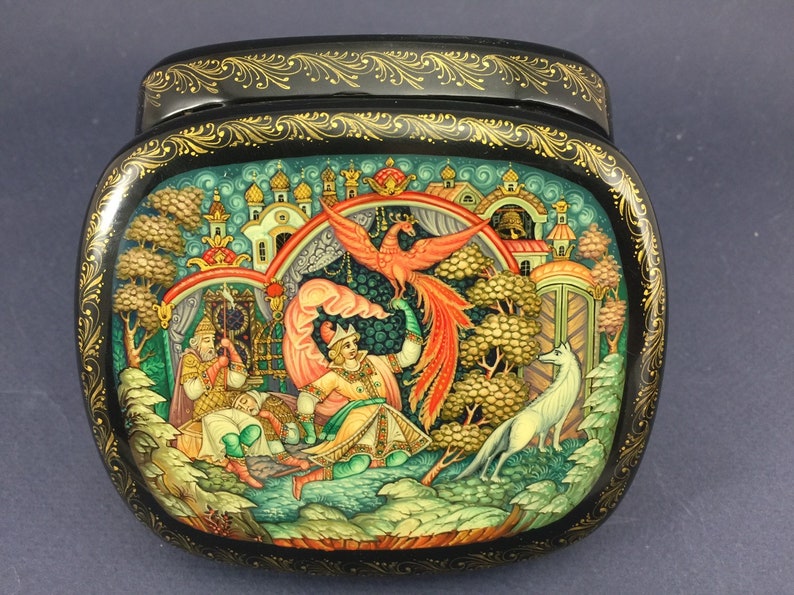

Palekh has a very long history in Russian iconography, the art of painting Russian Orthodox icons for homes and churches. Palekh and Mstyora are villages with population about 5000 each. If you look on a map the closest international airport to the area where artists created these boxes would be Moscow. Mstyora is a village close to Palekh village where the box was manufactured.These boxes were manufactures in Ivanovo Region of Russia where both Palekh and Mstyora are located. This could to some extent explain lack of the artist's full name on his work.If you look at the bottom left corner of the design you'll see a word that starts with 'M' and reads Mstyora in Russian. To me English writing on a traditional box represents the fact that the box was intended to be sold abroad or presented as a gift to a foreign guest. The bottom of the box is marked 'Made in USSR' in English. I believe it will take a while to sell this masterpiece for anything close to the price quote I found, so I'm pricing it to sell.The top of the box is marked 'General Toptygin' which is the name for the box design - a rather well known Russian fairy tale about a bear (you see him in the sled carried away by Troika). When I price my items I take into consideration condition, design and market. A smaller lacquer box of comparable design created by him is currently available on a Russian antique Palekh website for a whopping $950. I've done some research and have learned that unknown Soviet artist who signed lacquer boxes 'M.B.' worked in the village of Mstyora in 1960-1965. Entirely hand painted by the artist it is at least 50 years old.The box is signed 'M.B.'. This is a larger than average box, measuring aprroximately 7'' x 5''. Suddenly the work of the Fedoskino miniaturists was desired by collectors outside of Russia and the Russian lacquer miniature became an export commodity.Up for auction is a true find - authentic 1960s Palekh lacquer box. The beautiful lacquer paintings were regarded as a unique folk art and were discovered by the international community.

This situation changed noticeably in the 1920s when Fedoskino lacquer miniatures were displayed at several international exhibitions. The years of World War I, the Revolution of 1917 and the subsequent civil war took a heavy toll on the craftsmen and artists of Fedoskino and the lacquer workshops often stood idle as a result of raw material shortages and little demand for finished goods. I think this depicts Ivan III Vasilyevich (Ivan the Great) defeating the Tatars. It could have been made in 1938 or it could have been the 38th box made by an artist with initials BD. It is signed by the artist but I know nothing about this signature. This is a Soviet era Russian Black Lacquer Box in the McTepa school style.


 0 kommentar(er)
0 kommentar(er)
